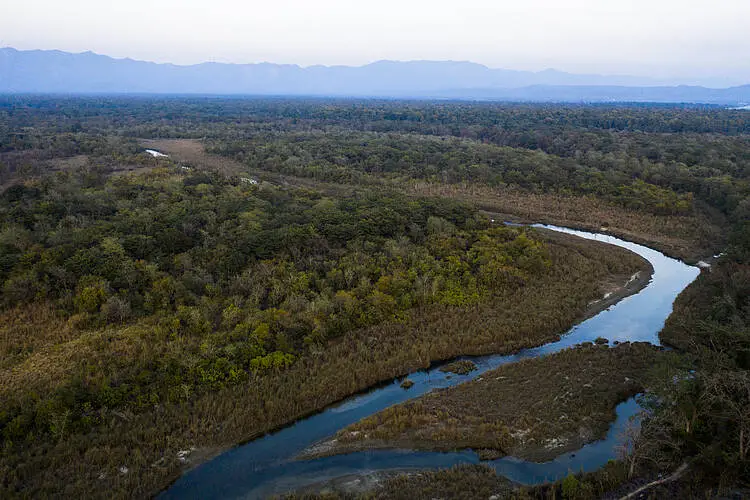India, a rich tapestry of biodiversity, showcases a range of ecosystems, with life flourishing across ten distinct biogeographic zones. Each zone reveals a unique ecological makeup, creating diverse habitats for a variety of species. Here’s an overview of India’s key forest types, notable national parks, and the wildlife species that call them home.
-
Tropical Rainforests

Characterized by towering trees that create a multi-layered canopy, tropical rainforests receive over 2000 mm of rainfall annually. Found in the Western Ghats, northeastern India, and the Andaman and Nicobar Islands, these lush forests house a wealth of species.
– Tree Species: Rosewood, Mahogany, Ebony, tree ferns, palms.
– Wildlife: Royal Bengal Tiger, Indian Leopard, Asian Elephant, Malabar Giant Squirrel, Hoolock Gibbon, and lion-tailed Macaque.
-
Tropical Moist Deciduous Forests
Receiving 1000-2000 mm of rainfall, these forests are dominated by deciduous trees that shed leaves in dry seasons. Covering 19.73% of India’s forested area, they are found across southern and northern regions.
– Tree Species: Sal, Teak, Bamboo, Palash, Semal.
– National Parks & Sanctuaries: Bandipur (Karnataka), Kanha (Madhya Pradesh), Dudhwa Tiger Reserve (Uttar Pradesh).
– Wildlife: Bengal Tiger, Indian Leopard, Indian Bison, Chital, Sambar Deer, various bird species.
-
Tropical Dry Deciduous Forests
These forests represent India’s most extensive forest type, receiving 800-1200 mm of rainfall. With a canopy of sun-loving trees, they extend from Kanyakumari to the Himalayan foothills.
– Tree Species: Acacia, Babul, Neem, Tamarind.
– National Parks & Sanctuaries: Ranthambore Tiger Reserve, Sariska Tiger Reserve (Rajasthan).
– Wildlife: Bengal Tiger, Sambar Deer, Indian Gazelle, Desert Fox, and reptiles.
-
Tropical Thorn Forests and Scrub

These forests thrive in low-rainfall regions (200-800 mm) and have sparse, thorny vegetation. Found in northern and central India, they are adapted to prolonged dry periods.
– Tree Species: Acacia, Prosopis.
– National Parks & Sanctuaries: Desert National Park (Rajasthan), Gir National Park (Gujarat).
– Wildlife: Indian Wolf, Striped Hyena, Indian Gazelle, Desert Fox, Indian Bustard.
-
Mangrove Forests
Mangroves, found along India’s coastlines, are adapted to saline and marshy environments. The Sundarbans, the largest mangrove forest, extends into West Bengal and is a critical habitat for diverse species.
– Tree Species: Sundari, Rhizophora, Avicennia, Sonneratia.
– National Parks & Sanctuaries: Sundarbans (West Bengal), Bhitarkanika (Odisha).
– Wildlife: Royal Bengal Tiger, Saltwater Crocodile, Indian Python, migratory birds.
-
Temperate Forests (Himalayan Region)

Stretching from Kashmir to Sikkim, these forests thrive at altitudes of 1500-3300 meters, hosting trees suited to cooler climates and lower rainfall.
– Tree Species: Deodar, Pine, Oak, Rhododendron.
– National Parks & Sanctuaries: Jim Corbett (Uttarakhand), Great Himalayan (Himachal Pradesh), Singalila (West Bengal).
– Wildlife: Common Leopard, Red Panda, Himalayan Musk Deer, Himalayan Tahr, pheasants.
-
Subtropical Forests
These forests span altitudes of 1000-2000 meters and are divided into Northern and Southern regions. Found across states like Arunachal Pradesh, Meghalaya, and Sikkim, they support dense evergreen vegetation.
– Tree Species: Sal, Oak, Chestnut, Rhododendron.
– National Parks & Sanctuaries: Rajaji (Uttarakhand), Simlipal (Odisha).
– Wildlife: Himalayan Black Bear, Sambar Deer, Serow, various bird species.
-
Alpine Forests
Located above the tree line in the Himalayas, these forests reach up to 5500 meters, where low-growing shrubs and alpine flora dominate.
– Tree Species: Sparse; primarily Rhododendron and Betula in lower alpine regions.
– National Parks & Sanctuaries: Valley of Flowers (Uttarakhand), Khangchendzonga (Sikkim).
– Wildlife: Snow Leopard, Himalayan Blue Sheep (Bharal), high-altitude birds.
About Sharad Vats
Sharad Vats, a wildlife photographer with over 30 years of experience, founded Nature Safari India Pvt Ltd, promoting conservation through tourism. His experiences inspired him to create jungle lodges in Kanha National Park and to write a book on leadership lessons from tigers, available on Amazon.
Related Articles
– Nagarhole National Park: Five Reasons to Visit Nagarhole, one of India’s premier tiger reserves.
– Strategic Predators: Explore the top 10 strategic predators of Indian wildlife.
– Offbeat Safari Destinations: Discover unique and less-visited Bengal Tiger safari destinations.

